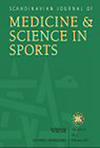8周中等或大容量力量训练对优秀男女赛艇运动员肌浆网Ca2+处理的影响
IF 3.5
2区 医学
Q1 SPORT SCIENCES
引用次数: 0
摘要
虽然急性运动影响肌浆网(SR)功能,但阻力训练的影响尚不清楚。本研究的目的是调查SR Ca2+处理可塑性响应中等和高容量力量训练的优秀赛艇运动员。20名优秀的男性赛艇运动员(n = 12)和女性赛艇运动员(n = 8)进行了为期8周的每周三次力量训练,并在训练期间随机分配进行3组(3‐SET)或从5组到10组(10‐SET)的10次重复训练。在干预前后采集骨骼肌活检,分析SR囊泡Ca2+处理、SR相关蛋白和肌球蛋白重链(MHC)组成。肌肉力量通过等距大腿中部牵拉(IMTP)测定。训练增加了SR Ca2+的总释放量(19%)和吸收率(34%),两组之间没有差异。SR蛋白分析显示出高变异性,但表明RYR1和SERCA1增加,而SERCA2减少,证实SR功能的变化,组间无差异。无论训练量如何,观察到MHCIIa的相对比例增加了9%,MHCI亚型减少了7%。IMTP总体增加了8%。与女性相比,男性表现出更高的SR Ca2+摄取和释放率,可能是由于MHCII比例更高。这些研究结果表明,8周的中等或大容量力量训练提高了优秀男女赛艇运动员SR囊泡Ca2+的摄取和释放率,并伴随着MHCIIa纤维类型的更大比例的转变。本文章由计算机程序翻译,如有差异,请以英文原文为准。
Effects of 8 Weeks of Moderate‐ or High‐Volume Strength Training on Sarcoplasmic Reticulum Ca2+ Handling in Elite Female and Male Rowers
While acute exercise affects sarcoplasmic reticulum (SR) function, the impact of resistance training remains unclear. The purpose of the present study was to investigate SR Ca2+ handling plasticity in response to moderate‐ and high‐volume strength training in elite rowers. Twenty elite male (n = 12) and female (n = 8) rowers performed three weekly strength training sessions for 8 weeks and were randomly allocated to either perform 3 sets (3‐SET) or progressive increase from 5 to 10 sets (10‐SET) of 10 repetitions during the training period. Skeletal muscle biopsies were collected before and after the intervention period and analyzed for SR vesicle Ca2+ handling, SR related proteins, and myosin heavy chain (MHC) composition. Muscle strength was determined by isometric midthigh pull (IMTP). Training increased both the overall SR Ca2+ release (19%) and uptake rates (34%), with no differences between groups. SR protein analysis revealed a high variability but suggests an increase of RYR1 and SERCA1, while SERCA2 decreased, corroborating changes in SR function, with no differences between groups. Regardless of training volume, a 9% higher relative MHCIIa proportion and a 7% decrease in the MHCI isoform was observed. There was an overall 8% increase of IMTP. Males exhibited higher SR Ca2+ uptake and release rates compared to females, likely explained by a higher proportion of MHCII. These findings suggest that 8 weeks of moderate‐ or high‐volume strength training enhances SR vesicle Ca2+ uptake and release rates in elite male and female rowers, accompanied by a shift toward a larger proportion of MHCIIa fiber type.
求助全文
通过发布文献求助,成功后即可免费获取论文全文。
去求助
来源期刊
CiteScore
7.90
自引率
4.90%
发文量
162
审稿时长
3 months
期刊介绍:
The Scandinavian Journal of Medicine & Science in Sports is a multidisciplinary journal published 12 times per year under the auspices of the Scandinavian Foundation of Medicine and Science in Sports.
It aims to publish high quality and impactful articles in the fields of orthopaedics, rehabilitation and sports medicine, exercise physiology and biochemistry, biomechanics and motor control, health and disease relating to sport, exercise and physical activity, as well as on the social and behavioural aspects of sport and exercise.

 求助内容:
求助内容: 应助结果提醒方式:
应助结果提醒方式:


